The Islamic State claims to have executed 489 “martyrdom operations” in Iraq, Syria and Libya during the first five months of 2016. The figure comes from monthly data published by Amaq News Agency, a propaganda arm of the so-called caliphate that releases infographics summarizing the group’s suicide attacks.
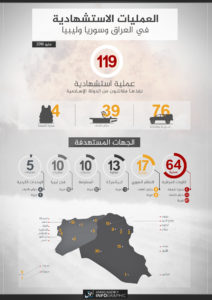
Amaq’s most recent infographic (seen on the right) indicates that the jihadists executed 119 “martyrdom operations” in the month of May alone. If Amaq’s figures are accurate, then the Islamic State is launching suicide attacks at a historically high rate.
Earlier this month, for example, the State Department reported that there were 726 “suicide attacks” executed by all perpetrators around the globe in 2015. Therefore, all terrorist groups, including the Islamic State, carried out an average of 61 suicide bombings per month in 2015. The Islamic State nearly doubled that rate in May and has exceeded it by more than 20 attacks each month this year, according to Amaq’s infographics.
The data referenced by Foggy Bottom are compiled by the National Consortium for the Study of Terrorism and Responses to Terrorism (START), which maintains an “unclassified event database compiled from information in open-source reports of terrorist attacks.”
According to START’s data, 2015 witnessed a record number of suicide bombings. But 2016 is currently on pace to eclipse that high-water mark.
While Amaq’s claims are difficult to independently verify, the statistics are reasonable given the scale of the Islamic State’s fighting. Abu Bakr al Baghdadi’s men routinely claim credit for simultaneous suicide bombings. The organization is taking on multiple adversaries in every country where it operates, making the use of suicide bombings (one of the jihadists’ most effective tactics) an especially important tool. For instance, the State Department noted that “[o]n average, suicide attacks in 2015 were 4.6 times as lethal as non-suicide attacks.”
A recent video from Al Hayat, another one of the Islamic State’s mouthpieces, trumpeted this “caliphate vs. the world” mentality. In “The Religion of Kufr Is One,” Al Hayat made it clear that Baghdadi’s enterprise is at war with virtually everyone else. The subtitle of the video, “The Islamic State and its methodology dealing with all apostate parties and nations of disbelief,” underscored the degree to which this is the group’s deliberate strategy.
The Islamic State’s prolific use of “martyrs” probably highlights both its strength and weakness. On the one hand, there are likely more people, predominately young men, willing to die for the jihadists’ cause today than ever. (It should also be noted that adolescents and even children have been used in suicide attacks.) On the other hand, most of the organization’s suicide attackers are being dispatched in areas where the “caliphate” is being challenged, including locations that were once under its control.
The Long War Journal assesses that Islamic State is being forced to deploy many of its “martyrs” because its territorial claims are being rolled back in Iraq, Syria and even Libya.
The Long War Journal has tallied the figures provided on Amaq’s infographics from January through May of 2016. The English-language versions of these infographics can be seen below.
The following observations have been culled from Amaq’s statistics.
Most of the Islamic State’s “martyrdom operations,” 303 of the 489 claimed (62 percent), have been carried out inside Iraq. Approximately half of these (152 of 303) have been launched in Anbar province, where the jihadists are engaged in fierce battles with Iraqi government forces and Iranian-backed Shiite militias for months. Salahuddin (52 suicide attacks), Nineveh (40), Baghdad (32), and Kirkuk (17) are the next most frequently targeted areas.
The Islamic State launched 175 suicide attacks in Syria (36 percent of the total) during the first five months of the year. Aleppo province (59) was hit most frequently, followed by Hasakah (33), Deir Ezzor (25), Homs (20) and Raqqa (14) provinces. Raqqa is, of course, the de facto capital of the Islamic State. Amaq’s data indicate that 12 of the 14 suicide attacks there this year were carried out in February.
The remaining 11 “martyrdom operations” took place in Libya. Interestingly, Amaq claimed only one suicide attack in Libya from January through April. But the infographic for May shows 10 such bombings. Nine of the 10 have been executed in and around Sirte, the group’s central base of operations in Libya. The Islamic State’s presence in Sirte has been under assault from multiple directions for weeks, with the jihadists losing their grip on some of the neighboring towns and key facilities. Thus, the group is likely attempting to stymie its rivals’ advances with the deployment of its suicide bombers.
Iraqi forces are the most frequent target of the Islamic State’s “martyrdom operations,” as they were hit 279 times from January through May. Bashar al Assad’s regime is the second most frequent target, with the Islamic State’s suicide bombers striking the Syrian government’s forces on 89 occasions. The remaining bombings struck “Kurdish units” (54), the “Syrian opposition” (31 times), the Peshmerga (25), Fajr Libya (10) and General Khalifa Haftar’s fighters in Libya (1).
Vehicle-borne improvised explosive devices (VBIEDs) are used more often than individual bombers strapped with explosives, according to Amaq. The infographics count 301 VBIEDs used in suicide attacks (62 percent of the total) as compared to 184 bombings using explosive belts, jackets and vests. The remaining four are listed as “dual operations.”
Assuming Amaq’s data are accurate, then the Islamic State’s “martyrdom” machine is setting a record pace for suicide operations.
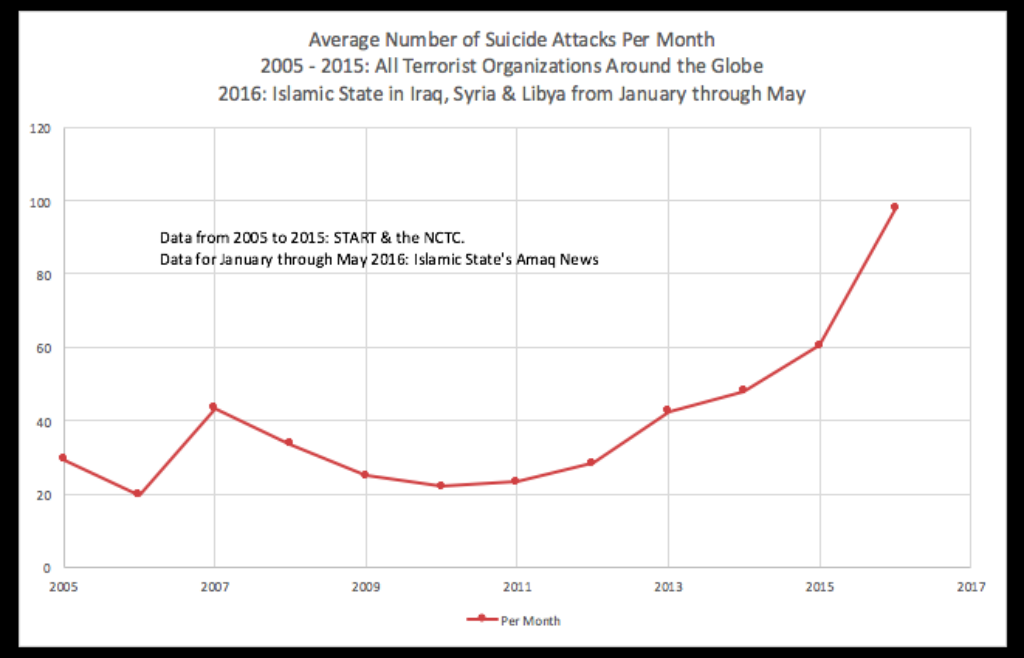
For illustrative purposes, The Long War Journal has compared Amaq’s claims to data reported in the State Department’s annual Country Reports on Terrorism from 2005 through 2015. The data for 2005 through 2011 come from the National Counterterrorism Center (NCTC), while the data from 2012 through 2015 were accumulated by START. The methodology for tracking terrorist attacks has evolved over time and this brief summary does not account for those changes.
As seen in the chart above, the data compiled by NCTC and START indicate that all terrorist organizations around the globe — including the Islamic State, al Qaeda and its regional branches, the Taliban, the Islamic State in West Africa (formerly known as Boko Haram), as well as other jihadi and non-jihadi terrorists — carried out an average of approximately 61 suicide attacks per month in 2015. In no prior year did this figure ever exceed 50. From 2009 through 2012, there were less than 30 suicide attacks per month globally.
The Islamic State claims that its fighters have executed nearly 98 “martyrdom operations” per month thus far in 2016. That is 37 more suicide attacks per month than all terrorist organizations combined in 2015.
It is worth mentioning again that there were more suicide bombings in 2015, 726 in all, than any previous year, according to NCTC’s and START’s statistics. Before that, 2014 witnessed an all-time high of 575 suicide bombings. Therefore, the trend line has been increasing in recent years. At its current pace (it is far from certain that the Islamic State can maintain it), the Islamic State would execute more than 1,100 suicide attacks this year just in Iraq, Syria and Libya. Amaq’s figures do not include suicide attacks carried out elsewhere.
To add more perspective to the Islamic State’s current “martyrdom operations,” consider data published by the Washington Post in 2008. According to the Post, there were just 54 suicide attacks in all of 2001, when al Qaeda’s “martyrs” launched the most devastating terrorist hijackings in history. Although the overwhelming majority of the Islamic State’s suicide assaults are launched primarily in war zones in the Middle East, with comparatively few in the West (Paris and Brussels), Baghdadi’s “martyrs” exceed this figure every month.
Whereas suicide bombings were relatively rare in 2001, they are now a common occurrence, especially in war zones such as Iraq and Syria.
Amaq’s English-language infographics on “martyrdom operations” from January through May 2016:
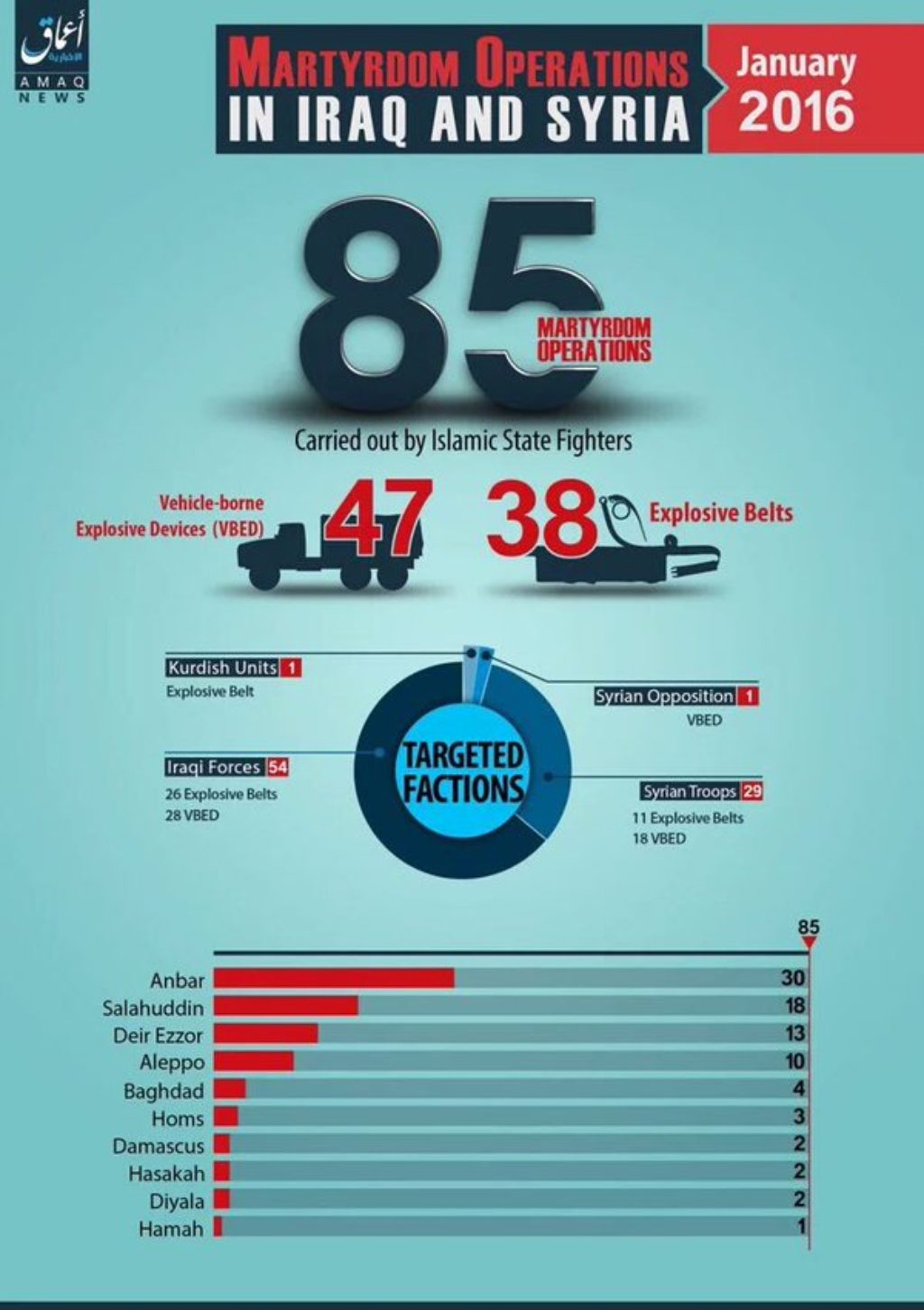
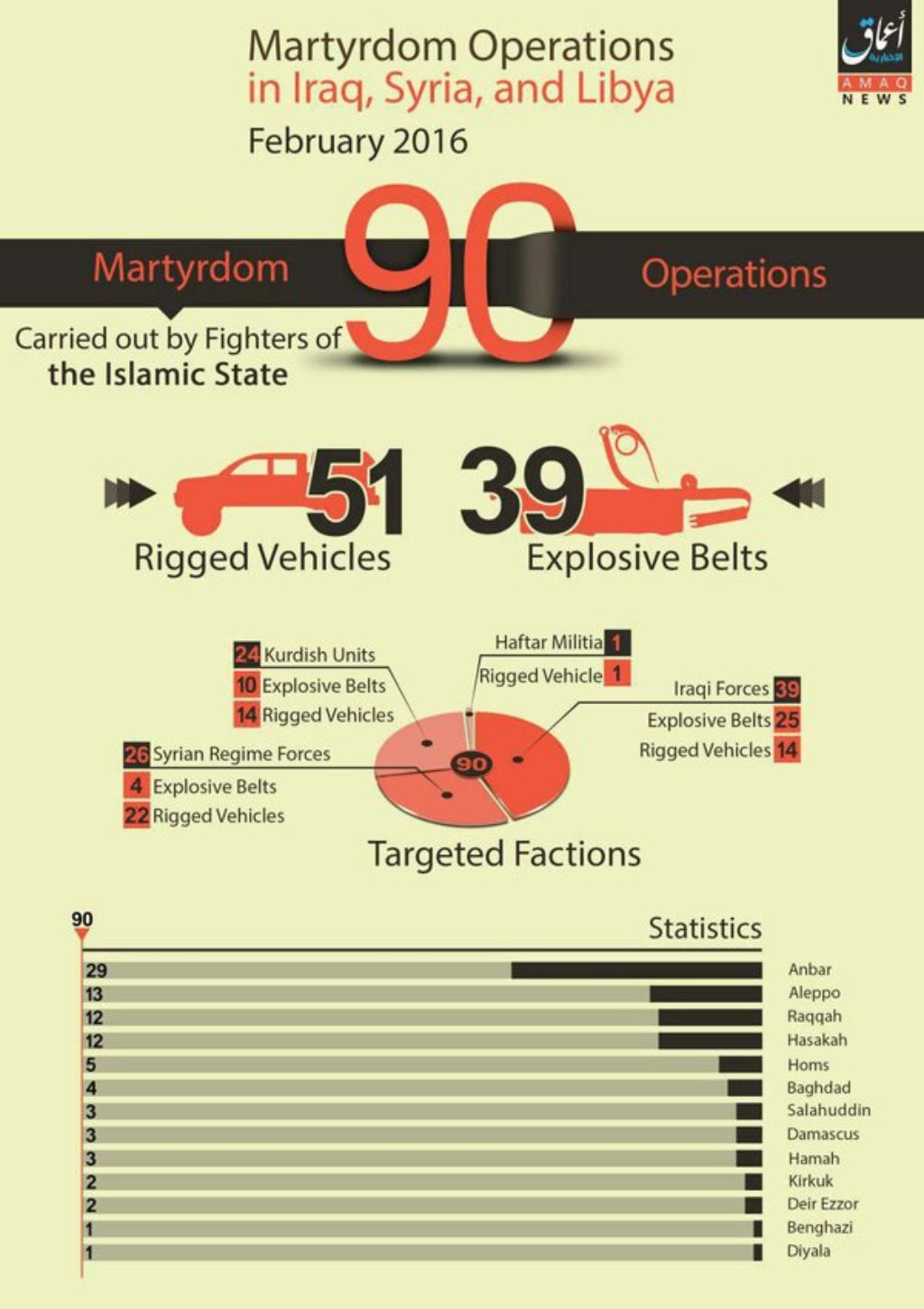
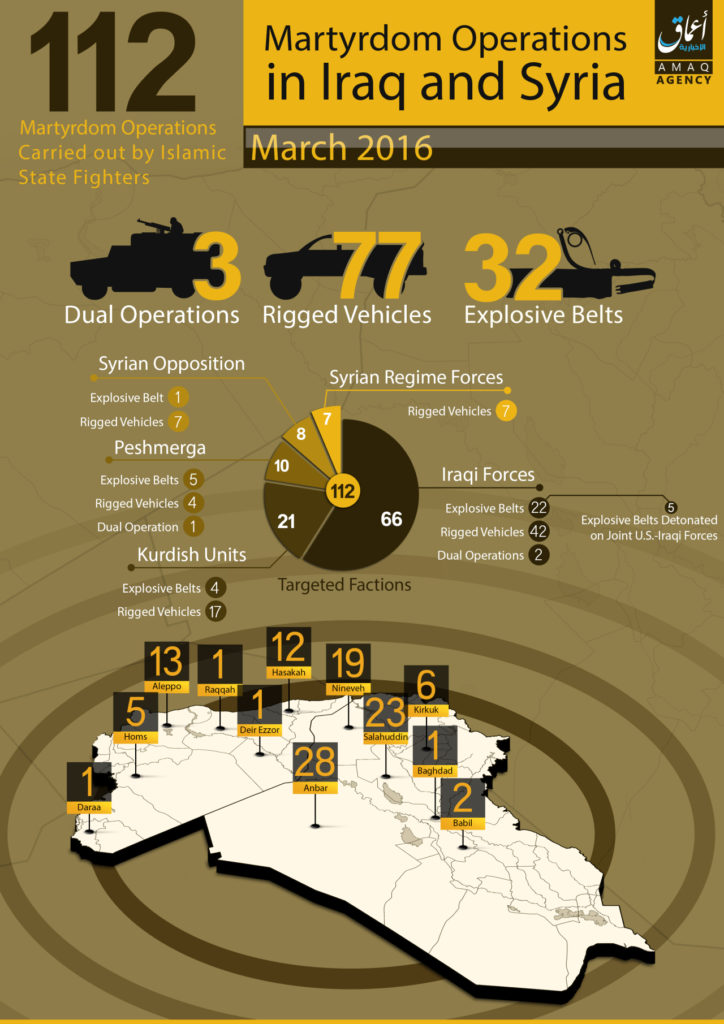
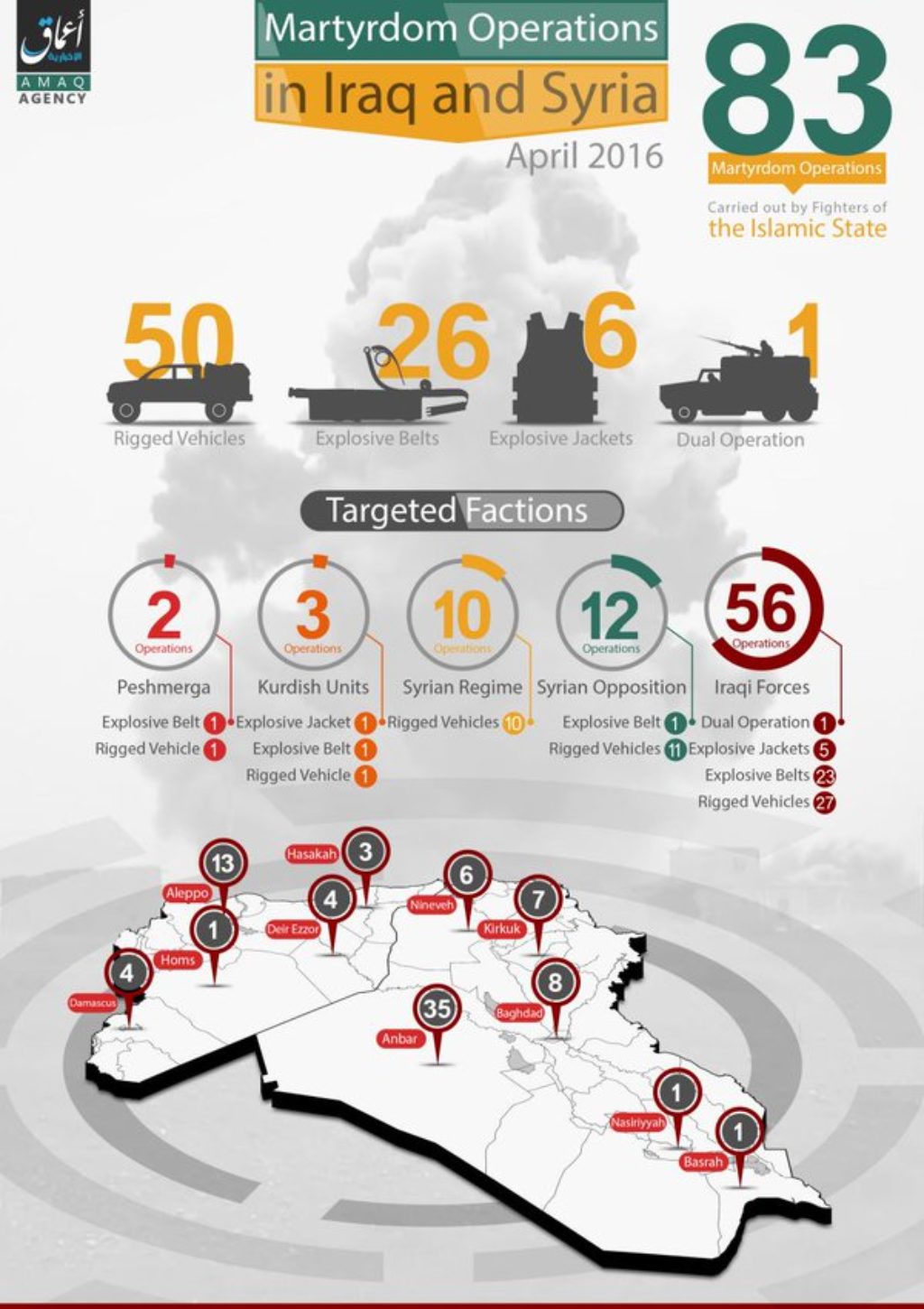
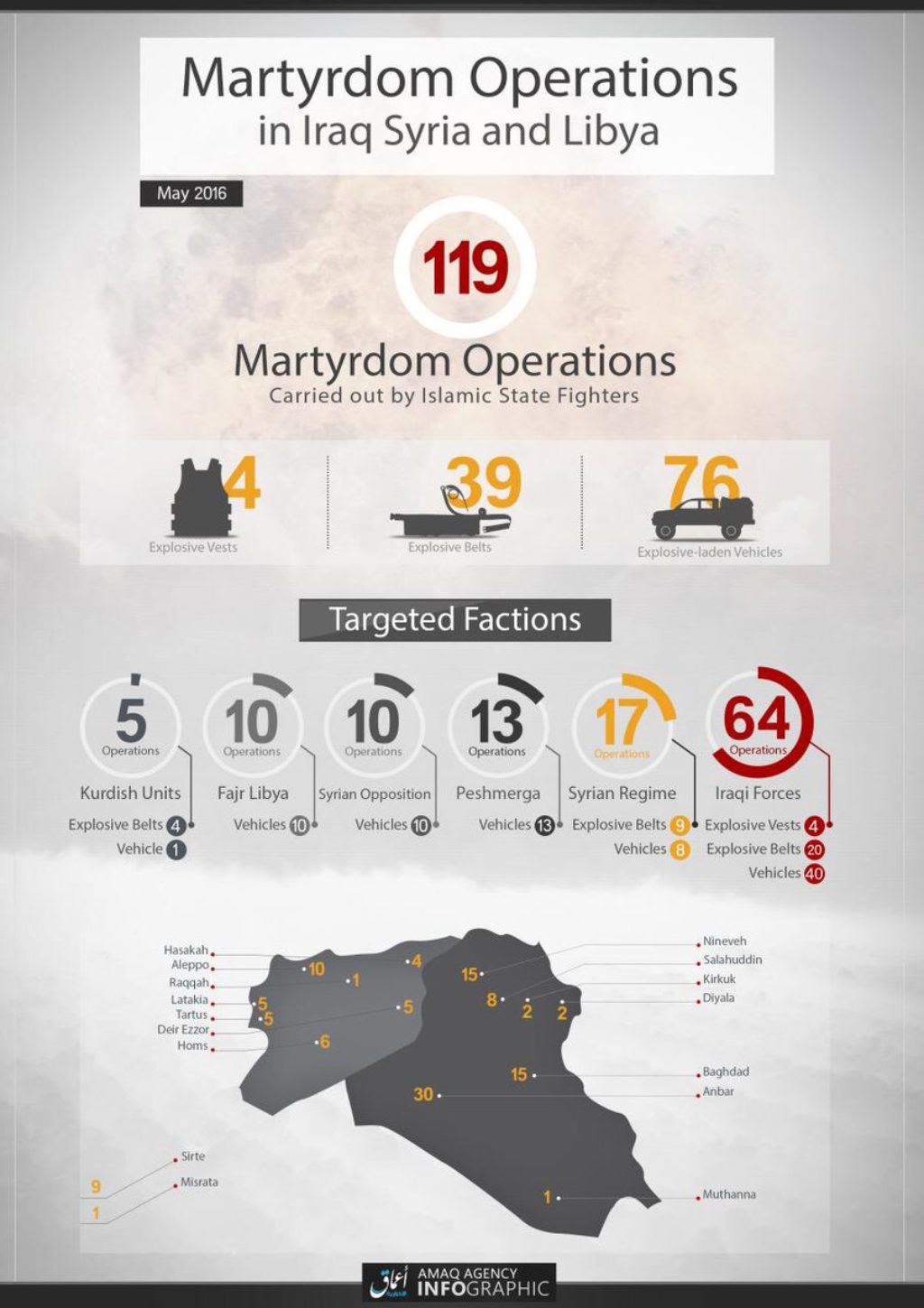








5 Comments
ISIS ATTACK WITH HUMANS BEINGS IN SPECIFIC TARGETS. THIS ORGANIZATION LIKE TO CHALLENGE AL-QAEDA IN ONE NEAR FUTURE.
If one takes these figures as ‘correct’ then there are certain factors to consider. Firstly, if you add the total number of attacks(regardless of type) from Jan 2016 to end of April 2016 and divide them by the number of countries you get an average figure per country. Whilst the graph shows an increase the actual number of attacks per day is approx 1.34 per country. Looking at the figures for May alone the average is 1.27 attacks per day per country. So a slight decrease. Notwithstanding the localised effect those numbers hardly denote a high tempo of operations. Whilst an average figure doesn’t show a true reflection of where the action is really taking place the ‘info graphic’ shows that most suicide attacks occur in Iraq, where IS is under the most pressure. Whilst ‘martyrdom’ is what most IS fighters say they want, the use of suicide bombers in the MO used by IS is hardly effective and is an act of desperation, in my opinion. Something similar to Hitler’s V weapons programme that began just after the D Day landings.
IS is struggling to maintain its position in Iraq, under pressure in Fallujah and many other locations around western Iraq. If Fallujah falls(it seems that may happen) then the next ‘key location’ is Mosul. Mosul is far more important to both IS and Iraq. That could be a blood bath but as IS captured Mosul with very little opposition, maybe they will return the favour.
Finally, back to the ‘info graphic’. Whilst they appear slick and modern. Lets not forget that they are merely a propaganda tool for IS. No doubt these so called ‘facts’ look interesting and may appeal to a younger generation they don’t actually show IS in a good light. If all those attacks had happened in one city, over the course of, say 2 weeks then we could say that IS had upped its tempo of operations and we would probably see some movement by them on a map sonewhere.
Breaking down the figures it appears to me that IS are merely creating ‘noise’ but the underlying info says they have their hands full ATM with their (many) adversaries.
How many of these attacks, or what percentage of the attacks are against civilian or government targets? If ALL the targets are military targets, it demonstrates that the group is using suicide attacks as a military tactic, not as a tactic of terror.
“martyrs”? to what? this conflict is so sad. these people are no more than human munitions. that they can attract so many “adventure seekers” from amongst the world’s muslims tells you what a sad faith that religion has become in modernity if so many of its followers want to throw their lives away as if they were just so many pounds of gunpowder. there are no virgins, there are no pearly gates. martyrdom is such a nihilistic concept at its core, but these poor human bombs can’t spell that, much less understand it, and their leaders are evil enough to manipulate them, lie to them and kill their own.
They are under much pressure, no doubt. Baghdadi got hit again. But look at what happened when we smashed AQ. They had kittens all over the world. That’s what I’m afraid is happening w IS. Even if they lose their main AO in Syraq, they will dig in elsewhere. UNLESS, we fight them harder, faster, more creatively now.